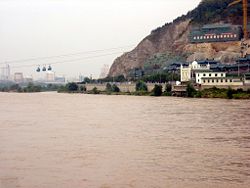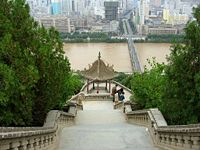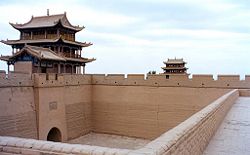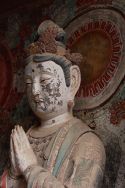Difference between revisions of "Gansu" - New World Encyclopedia
Nim Ruparel (talk | contribs) |
Nim Ruparel (talk | contribs) |
||
| Line 36: | Line 36: | ||
| Website = http://www.gansu.gov.cn <br /> ([[Simplified Chinese]]) | | Website = http://www.gansu.gov.cn <br /> ([[Simplified Chinese]]) | ||
}} | }} | ||
| − | '''{{Audio|zh-Gansu.ogg|Gansu}}''' ({{zh-stpw |s=甘肃 |t=甘肅 |p=Gānsù |w=Kan-su, Kansu, or Kan-suh}}) is a [[political divisions of China|province]] of the [[People's Republic of China]] located in the northwest region of the country. It lies between [[Qinghai]], [[Inner Mongolia]], and the [[Loess Plateau|Huangtu Plateaus]], and borders [[Mongolia]] to the north and [[Xinjiang]] to the west. The [[Huanghe River]] passes through the southern part of the province. It has a population of approximately 25 million (1997) and has a large concentration of [[Hui Chinese]]. The capital of the province is [[Lanzhou]], located in the southeast part of Gansu. Gansu is abbreviated Gan or Long (陇/隴), and is also known as Long West or Long Right, in reference to the Long Mountain that lies east of Gansu. | + | '''{{Audio|zh-Gansu.ogg|Gansu}}''' ({{zh-stpw |s=甘肃 |t=甘肅 |p=Gānsù |w=Kan-su, Kansu, or Kan-suh}}) is a [[political divisions of China|province]] of the [[People's Republic of China]] located in the northwest region of the country. It lies between [[Qinghai]], [[Inner Mongolia]], and the [[Loess Plateau|Huangtu Plateaus]], and borders [[Mongolia]] to the north and [[Xinjiang]] to the west. The [[Huanghe River]] passes through the southern part of the province. It has a population of approximately 25 million (1997) and has a large concentration of [[Hui Chinese]] as well as a variety of other ethnic groups. The capital of the province is [[Lanzhou]], located in the southeast part of Gansu. Gansu is abbreviated Gan or Long (陇/隴), and is also known as Long West or Long Right, in reference to the Long Mountain that lies to the east of Gansu. |
| + | |||
| − | |||
| − | |||
| − | |||
| − | |||
| − | |||
| − | |||
| − | |||
| − | |||
| − | |||
| − | |||
| − | |||
| − | |||
| − | |||
| − | |||
| − | |||
| − | |||
| − | |||
== History == | == History == | ||
| − | + | Gansu originally began as an [[acronym]] that was first used during the [[Song Dynasty]] in reference to two [[Sui Dynasty|Sui]] and [[Tang Dynasty|Tang]] Dynasty [[prefecture]]s (州): Gan (which is located around modern day [[Zhangyi]]) and Su (located around modern day [[Jiuquan]]). | |
| − | Gansu | ||
| − | In prehistoric times, Gansu was host to a number of [[Neolithic]] cultures. The [[Dadiwan culture]], from where numerous archaeologically significant [[Artifact (archaeology)|artifact]]s have been excavated, flourished in the eastern end of Gansu from about [[6000 B.C.E.]] to about [[3000 B.C.E.]] <ref>[http://www.china.org.cn/english/2002/Nov/48266.htm]</ref>. The [[Majiayao culture]] (馬家窯文化) and part of the [[Qijia culture]] (齊家文化) also took root in Gansu from [[3100 B.C.E.]] to [[2700 B.C.E.]] and [[2400 B.C.E.]] to [[1900 B.C.E.]] respectively. | + | In prehistoric times however, Gansu was host to a number of [[Neolithic]] cultures. The [[Dadiwan culture]], from where numerous archaeologically significant [[Artifact (archaeology)|artifact]]s have been excavated, flourished in the eastern end of Gansu from about [[6000 B.C.E.]] to about [[3000 B.C.E.]] <ref>[http://www.china.org.cn/english/2002/Nov/48266.htm]</ref>. The [[Majiayao culture]] (馬家窯文化) and part of the [[Qijia culture]] (齊家文化) also took root in Gansu from [[3100 B.C.E.]] to [[2700 B.C.E.]] and [[2400 B.C.E.]] to [[1900 B.C.E.]] respectively. |
| − | The [[Qin (state)|Qin | + | The [[Qin (state)|state of Qin]] (秦), which later became the [[Qin dynasty|founding state]] of the [[Chinese empire]], grew from the southeastern part of Gansu, specifically in the [[Tianshui]] (天水) area. The actual name [[Qin (surname)|Qin]] is believed to have originated, in part, from the area. <ref>[http://news.xinhuanet.com/english/2006-11/19/content_5349258.htm]</ref><ref>[http://english.people.com.cn/200602/20/eng20060220_244270.html]</ref>. Over the years, various [[Qin (state)|Qin]] tombs and artifacts have been excavated from [[Fangmatan]] near [[Tianshui]], including a 2,200 year old map of [[Guixian county]] <ref>[http://news.xinhuanet.com/english/2002-04/30/content_378835.htm]</ref>. |
| − | + | During imperial times, Gansu was an important strategic outpost and communications link for the Chinese empire, as the [[Hexi corridor]] (which connects [[China]] to [[Central Asia]]) runs along the "neck" of the province. The [[Han dynasty]] extended the [[Great Wall of China|Great Wall]] across this corridor, and also built the strategic [[Yumenguan]] (Jade Gate Pass, near [[Dunhuang]]) and [[Yangguan]] ([[:zh:阳关|阳关]]) fort towns alongside the wall. As a result, prominent remains of both the wall and the towns can be found there to this date. The [[Ming dynasty]] also contributed to this type of construction, by building the [[Jiayuguan]] outpost in Gansu. To the west of [[Yumenguan]] and the [[Qilian mountains]], near the northwestern end of the province, the [[Yuezhi]], [[Wusun]], and other [[nomad]]ic tribes dwelt and occasionally figured into regional imperial Chinese [[geopolitics|geopolotical]] struggles. | |
| − | Situated along the [[Silk Road]], Gansu | + | Situated along the [[Silk Road]], Gansu historically has served a dual role both as an economically important province and a cultural transmission vector to the rest of [[Asia]]. [[Temple]]s and [[Buddhist]] [[grotto]]es <ref>[http://english.people.com.cn/200201/03/eng20020103_87985.shtml]</ref> such as those at [[Mogao Caves]] ('Caves of the Thousand Buddhas') and [[Maijishan Caves]] contain artistically and historically revealing [[mural]]s.<ref>"Artistic treasures of Maiji Mountain caves" by Alok Shrotriya and Zhou Xue-ying. [http://www.asianart.com/articles/alok/index.html]</ref> An early form of [[paper]] inscribed with [[Chinese writing|Chinese characters]] and dating to about [[8 B.C.E.]] has also been discovered at the site of a Western Han [[garrison]] near the Yumen pass in [[August]] [[2006]] <ref>[http://news.xinhuanet.com/english/2006-08/08/content_4937457.htm]</ref>. |
Many parts of the province saw heavy fighting during the [[Muslim Rebellion]] of 1862-77. | Many parts of the province saw heavy fighting during the [[Muslim Rebellion]] of 1862-77. | ||
| Line 74: | Line 57: | ||
== Geography == | == Geography == | ||
[[Image:Lanzhou-rio-amarillo-d01.jpg|thumb|right|250px|The Yellow River crossing Lanzhou.]] | [[Image:Lanzhou-rio-amarillo-d01.jpg|thumb|right|250px|The Yellow River crossing Lanzhou.]] | ||
| − | Gansu province has an area of 454,000 [[Square kilometre|km²]], and the majority of its land is more than 1 km above [[sea level]]. It lies between the [[Tibetan Plateau]], [[Inner Mongolia]], and the [[Loess]] Plateau, and borders [[Mongolia]] to the north-west | + | Gansu province has an area of 454,000 [[Square kilometre|km²]], and the majority of its land is more than 1 km above [[sea level]]. It lies between the [[Tibetan Plateau]], [[Inner Mongolia]], and the [[Loess]] Plateau, and borders [[Mongolia]] to the north-west, with part of the [[Gobi Desert]] being located in Gansu. |
| − | + | The [[Yellow River]] ([[Huang He]]) gets most of its water from Gansu province, and it flows straight through the capital city of [[Lanzhou]]. | |
| − | The | + | Much like the rest of northwest China, the landscape in Gansu is very mountainous, especially in the south. The mountains in the south are part of the [[Qilian]] mountain range, which contain's the province's highest elevation point, the Qilian Shan Mountain, which is about 5,547 meters high. It is located at latitude 39°N and longitude 99°E. |
| − | The | + | The province contains the [[geographical center]] of China, marked by the Center of the County Monument at {{coor dms|35|50|40.9|N|103|27|7.5|E|region:CN_type:landmark|name=Geographical centre of China}} [http://english.people.com.cn/english/200009/13/eng20000913_50419.html]. |
| − | + | Major cities: | |
| − | |||
| − | |||
* [[Lanzhou]] | * [[Lanzhou]] | ||
* [[Yumen]] | * [[Yumen]] | ||
* [[Xiahe]] | * [[Xiahe]] | ||
| + | |||
| + | Major rivers and lakes: | ||
| + | * [[Yellow River]] | ||
| + | |||
| + | == Administrative divisions == | ||
| + | {{main|List of administrative divisions of Gansu}} | ||
| + | |||
| + | There are fourteen administrative divisions in Gansu immediately below the province level: twelve [[prefecture-level cities]] and two autonomous prefectures: | ||
| + | |||
| + | * [[Baiyin]] City (白银 Báiyín) | ||
| + | * [[Dingxi]] City (定西 Dìngxī) | ||
| + | * [[Gannan Tibetan Autonomous Prefecture]] (甘南 : Gānnán Zāngzú) | ||
| + | * [[Jiayuguan]] City (嘉峪关 : Jiāyùguān) | ||
| + | * [[Jinchang]] City (金昌 : Jīnchāng) | ||
| + | * [[Jiuquan]] City (酒泉 : Jiǔquán) | ||
| + | * [[Lanzhou]] City (兰州 : Lánzhōu) | ||
| + | * [[Linxia Hui Autonomous Prefecture]] (临夏 : Línxià Huízú) | ||
| + | * [[Longnan]] City (陇南 : Lǒngnán) | ||
| + | * [[Pingliang]] City (平凉 : Píngliàng) | ||
| + | * [[Qingyang]] City (庆阳 : Qìngyáng) | ||
| + | * [[Tianshui]] City (天水 : Tiānshuǐ) | ||
| + | * [[Wuwei]] City (武威 : Wǔwēi) | ||
| + | * [[Zhangye]] City (张掖 : Zhāngyè) | ||
| + | |||
| + | The twelve [[Political divisions of China#Prefecture-level|prefecture-level divisions]] of Gansu are subdivided into 86 [[Political divisions of China#County-level|county-level divisions]], including 17 [[District of China|district]]s, 4 [[county-level cities]], 58 [[County of China|counties]], and 7 [[autonomous counties]]. These [[Political divisions of China#County-level|county-level divisions]] are then further divided into 1348 [[Political divisions of China#Township-level|township-level divisions]], resulting in 457 [[town of China|town]]s, 740 [[township of China|township]]s, 30 [[ethnic township]], and 121 [[subdistrict]]s. | ||
== Economy == | == Economy == | ||
| Line 120: | Line 126: | ||
== Tourism == | == Tourism == | ||
| − | [[Image: | + | [[Image:JiayuguanFort.jpg|thumb|right|250px|[[Jiayuguan Pass|Jiayuguan]] Fort.]] |
Jiayuguan Pass, in [[Jiayuguan]] city, is the largest and most intact pass, or entrance, of the [[Great Wall of China|Great Wall]]. Jiayuguan Pass was built in the early Ming dynasty, somewhere around the year [[1372]]. It was built near an oasis that was then on the extreme western edge of China. Jiayuguan Pass was the first pass on the west end of the great wall so it earned the name “The First And Greatest Pass Under Heaven.” | Jiayuguan Pass, in [[Jiayuguan]] city, is the largest and most intact pass, or entrance, of the [[Great Wall of China|Great Wall]]. Jiayuguan Pass was built in the early Ming dynasty, somewhere around the year [[1372]]. It was built near an oasis that was then on the extreme western edge of China. Jiayuguan Pass was the first pass on the west end of the great wall so it earned the name “The First And Greatest Pass Under Heaven.” | ||
| Line 126: | Line 132: | ||
The [[Mogao Caves|Mogao Grottoes]] near [[Dunhuang]] represent an astonishing collection of [[Buddhism|Buddhist]] art and religion. Originally there were a thousand grottoes, but now only 492 cave temples remain. Each temple has a large statue of a [[buddha]] or [[bodhisattva]] and paintings of religious scenes. In [[336]] AD, a monk named [[Lo-tsun|Le Zun (Lo-tsun)]] came near Echoing Sand Mountain, when he had a vision of golden rays of light shining down on him like a thousand Buddhas. Le Zun started to carve the first grotto to memorize the incident. During the [[Five Dynasties and Ten Kingdoms Period|Five Dynasties period]] they ran out of room on the cliff and could not build anymore grottoes. Now they have started to find old paintings that were painted over in the Five Dynasties. | The [[Mogao Caves|Mogao Grottoes]] near [[Dunhuang]] represent an astonishing collection of [[Buddhism|Buddhist]] art and religion. Originally there were a thousand grottoes, but now only 492 cave temples remain. Each temple has a large statue of a [[buddha]] or [[bodhisattva]] and paintings of religious scenes. In [[336]] AD, a monk named [[Lo-tsun|Le Zun (Lo-tsun)]] came near Echoing Sand Mountain, when he had a vision of golden rays of light shining down on him like a thousand Buddhas. Le Zun started to carve the first grotto to memorize the incident. During the [[Five Dynasties and Ten Kingdoms Period|Five Dynasties period]] they ran out of room on the cliff and could not build anymore grottoes. Now they have started to find old paintings that were painted over in the Five Dynasties. | ||
| + | [[Image:Bodhisattva at MaiJiShan.jpg|thumbnail|left|125px|Bodhisattva statue at Mai Ji Shan]] | ||
The historic [[Silk Road]] starts in [[Chang'an]] and goes to [[Constantinople]]. On the way merchants would go to Dunhuang in Gansu. In Dunhuang they would get fresh camels, food and guards for the journey around the dangerous [[Taklamakan Desert]]. Before departing Dunhuang they would pray to the Mogao Grottoes for a safe journey, if they came back alive they would thank the gods at the grottoes. Across the desert they would form a train of camels to protect themselves from thieving bandits. The next stop, [[Kashgar|Kashi (Kashgar)]], was a welcome sight to the merchants. At Kashi most would trade and go back and the ones who stayed would eat fruit and trade their [[Bactrian camel]]s for [[Dromedary|single humped]] ones. After Kashi they would keep going until they reached their next destination. | The historic [[Silk Road]] starts in [[Chang'an]] and goes to [[Constantinople]]. On the way merchants would go to Dunhuang in Gansu. In Dunhuang they would get fresh camels, food and guards for the journey around the dangerous [[Taklamakan Desert]]. Before departing Dunhuang they would pray to the Mogao Grottoes for a safe journey, if they came back alive they would thank the gods at the grottoes. Across the desert they would form a train of camels to protect themselves from thieving bandits. The next stop, [[Kashgar|Kashi (Kashgar)]], was a welcome sight to the merchants. At Kashi most would trade and go back and the ones who stayed would eat fruit and trade their [[Bactrian camel]]s for [[Dromedary|single humped]] ones. After Kashi they would keep going until they reached their next destination. | ||
Revision as of 19:38, 15 November 2007
| 甘肃省 Gānsù Shěng | |
| Abbreviations: 甘 or 陇 (Pinyin: Gān or Lǒng) | |
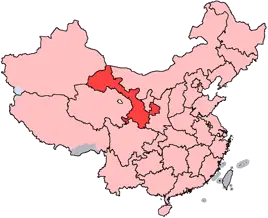
| |
| Origin of name | 甘 gān - Ganzhou (Zhangye) 肃 sù - Suzhou (Jiuquan) |
| Administration type | Province |
| Capital (and largest city) |
Lanzhou |
| CPC Ctte Secretary | Su Rong |
| Governor | Xu Shousheng (acting) |
| Area | 454,000 km² (7th) |
| Population (2004) - Density |
26,190,000 (22nd) 57.7/km² (27th) |
| GDP (2005) - per capita |
CNY 192.8 billion (27th) CNY 7,487 (29th) |
| HDI (2005) | 0.675 (medium) (28th) |
| Major nationalities | Han - 91% Hui - 5% Dongxiang - 2% Tibetan - 2% |
| Prefecture-level | 14 divisions |
| County-level | 86 divisions |
| Township-level† | 1344 divisions |
| ISO 3166-2 | CN-62 |
| Official website http://www.gansu.gov.cn (Simplified Chinese) | |
| Source for population and GDP data: 《中国统计年鉴—2005》 China Statistical Yearbook 2005 Source for nationalities data:ISBN 7503747382 《2000年人口普查中国民族人口资料》 Tabulation on nationalities of 2000 population census of China † As at December 31, 2004
ISBN 7105054255 | |
Gansu ▶ (Simplified Chinese: 甘肃; Traditional Chinese: 甘肅; pinyin: Gānsù; Wade-Giles: Kan-su, Kansu, or Kan-suh) is a province of the People's Republic of China located in the northwest region of the country. It lies between Qinghai, Inner Mongolia, and the Huangtu Plateaus, and borders Mongolia to the north and Xinjiang to the west. The Huanghe River passes through the southern part of the province. It has a population of approximately 25 million (1997) and has a large concentration of Hui Chinese as well as a variety of other ethnic groups. The capital of the province is Lanzhou, located in the southeast part of Gansu. Gansu is abbreviated Gan or Long (陇/隴), and is also known as Long West or Long Right, in reference to the Long Mountain that lies to the east of Gansu.
History
Gansu originally began as an acronym that was first used during the Song Dynasty in reference to two Sui and Tang Dynasty prefectures (州): Gan (which is located around modern day Zhangyi) and Su (located around modern day Jiuquan).
In prehistoric times however, Gansu was host to a number of Neolithic cultures. The Dadiwan culture, from where numerous archaeologically significant artifacts have been excavated, flourished in the eastern end of Gansu from about 6000 B.C.E. to about 3000 B.C.E. [1]. The Majiayao culture (馬家窯文化) and part of the Qijia culture (齊家文化) also took root in Gansu from 3100 B.C.E. to 2700 B.C.E. and 2400 B.C.E. to 1900 B.C.E. respectively.
The state of Qin (秦), which later became the founding state of the Chinese empire, grew from the southeastern part of Gansu, specifically in the Tianshui (天水) area. The actual name Qin is believed to have originated, in part, from the area. [2][3]. Over the years, various Qin tombs and artifacts have been excavated from Fangmatan near Tianshui, including a 2,200 year old map of Guixian county [4].
During imperial times, Gansu was an important strategic outpost and communications link for the Chinese empire, as the Hexi corridor (which connects China to Central Asia) runs along the "neck" of the province. The Han dynasty extended the Great Wall across this corridor, and also built the strategic Yumenguan (Jade Gate Pass, near Dunhuang) and Yangguan (阳关) fort towns alongside the wall. As a result, prominent remains of both the wall and the towns can be found there to this date. The Ming dynasty also contributed to this type of construction, by building the Jiayuguan outpost in Gansu. To the west of Yumenguan and the Qilian mountains, near the northwestern end of the province, the Yuezhi, Wusun, and other nomadic tribes dwelt and occasionally figured into regional imperial Chinese geopolotical struggles.
Situated along the Silk Road, Gansu historically has served a dual role both as an economically important province and a cultural transmission vector to the rest of Asia. Temples and Buddhist grottoes [5] such as those at Mogao Caves ('Caves of the Thousand Buddhas') and Maijishan Caves contain artistically and historically revealing murals.[6] An early form of paper inscribed with Chinese characters and dating to about 8 B.C.E. has also been discovered at the site of a Western Han garrison near the Yumen pass in August 2006 [7].
Many parts of the province saw heavy fighting during the Muslim Rebellion of 1862-77.
Its frequent earthquakes, droughts and famines have tended to slow its economic progress, until recently when based on its abundant mineral resources it has begun developing into a vital industrial center. An earthquake in Gansu at 8.6 on the Richter scale killed around 180,000 people in 1920, and another with a magnitude of 7.6 killed 70,000 in 1932.
Geography
Gansu province has an area of 454,000 km², and the majority of its land is more than 1 km above sea level. It lies between the Tibetan Plateau, Inner Mongolia, and the Loess Plateau, and borders Mongolia to the north-west, with part of the Gobi Desert being located in Gansu.
The Yellow River (Huang He) gets most of its water from Gansu province, and it flows straight through the capital city of Lanzhou.
Much like the rest of northwest China, the landscape in Gansu is very mountainous, especially in the south. The mountains in the south are part of the Qilian mountain range, which contain's the province's highest elevation point, the Qilian Shan Mountain, which is about 5,547 meters high. It is located at latitude 39°N and longitude 99°E.
The province contains the geographical center of China, marked by the Center of the County Monument at {{#invoke:Coordinates|coord}}{{#coordinates:35|50|40.9|N|103|27|7.5|E|region:CN_type:landmark | |name=Geographical centre of China }} [8].
Major cities:
- Lanzhou
- Yumen
- Xiahe
Major rivers and lakes:
Administrative divisions
There are fourteen administrative divisions in Gansu immediately below the province level: twelve prefecture-level cities and two autonomous prefectures:
- Baiyin City (白银 Báiyín)
- Dingxi City (定西 Dìngxī)
- Gannan Tibetan Autonomous Prefecture (甘南 : Gānnán Zāngzú)
- Jiayuguan City (嘉峪关 : Jiāyùguān)
- Jinchang City (金昌 : Jīnchāng)
- Jiuquan City (酒泉 : Jiǔquán)
- Lanzhou City (兰州 : Lánzhōu)
- Linxia Hui Autonomous Prefecture (临夏 : Línxià Huízú)
- Longnan City (陇南 : Lǒngnán)
- Pingliang City (平凉 : Píngliàng)
- Qingyang City (庆阳 : Qìngyáng)
- Tianshui City (天水 : Tiānshuǐ)
- Wuwei City (武威 : Wǔwēi)
- Zhangye City (张掖 : Zhāngyè)
The twelve prefecture-level divisions of Gansu are subdivided into 86 county-level divisions, including 17 districts, 4 county-level cities, 58 counties, and 7 autonomous counties. These county-level divisions are then further divided into 1348 township-level divisions, resulting in 457 towns, 740 townships, 30 ethnic township, and 121 subdistricts.
Economy
Agricultural production includes cotton, linseed oil, maize, melons (the Bailan melon is well known in China), millet, and wheat. Gansu is known as a source for wild medicinal herbs which are used in Chinese medicine. Gansu province is second place in China for most medicinal plants and herbs, including some odd ones like hairy asiabell root, fritillary bulb, and Chinese caterpillar fungus.
However, most of Gansu's economy is based on mining and the extraction of minerals, especially rare earth elements. The province has significant deposits of antimony, chromium, coal, cobalt, copper, fluorite, gypsum, iridium, iron, lead, limestone, mercury, mirabilite, nickel, crude oil, platinum, troilite, tungsten, and zinc among others. The oil fields at Yumen and Changqing are considered significant.
Industries other than mining include electricity generation, petrochemicals, oil exploration machinery, and building materials. Among Gansu’s most important sources of energy are its water resources: the Yellow River and other inland river drainage basins. Gansu is placed ninth among China’s provinces in annual hydropower potential and water discharge. Gansu produces 17.24 gigawatts of hydropower a year. Twenty-nine hydropower stations have been constructed in Gansu, each capable of generating 30 gigawatts. Gansu has an estimated coal reserve of 8.92 billion tons and petroleum reserve of 700 million tons. There is also good potential for wind and solar power development. According to some sources, the province is also a center of China's nuclear industry.
Gansu is considered to be one of the poorest provinces in China. Its nominal GDP for 2004 was about 155.9 billion yuan (19.34 billion USD) and per capita of 5010 RMB (605 USD).
Demographics
Gansu province is home to 26,033,400 people. Most of the population, 73%, is still rural. Gansu is 92% Han and also has Hui, Tibetan, Dongxiang, Tu, Manchu, Uyghur, Yugur, Bonan, Mongolian, Salar, and Kazakh minorities.
Education
According to statistics taken in 2000, there were 18 institutions of higher education in Gansu, with 81,700 students and 7,208 teachers. There were also 3,661 secondary schools and regular secondary schools with 2,764,300 students and 159,492 teachers as well as 21,557 primary schools with 3,164,600 students and 125,712 teachers. The school-age child enrollment rate was 98.83%.
Although education has developed rapidly in Gansu, the overall education level remains low, and the nine-year compulsory education requirement that was implemented to raise standards has not become popular in the province. In order to improve the academic system in the province, a stronger effort must be made in increasing the amount of investment in education and improving educational facilities. In addition, illiteracy-alleviation measures still need to be carried out in order to bring Gansu closer to the level of some of the other provinces in China.
Colleges and universities
- Lanzhou University (Lanzhou)
- Gansu Agricultural University
Culture
The cuisine of Gansu is based on the staple crops grown there: wheat, barley, millet, beans, and sweet potatoes. Within China, Gansu is known for its pulled noodles, and Muslim restaurants which feature authentic Gansu cuisine are common in most major Chinese cities.
Most of the inhabitants of Gansu speak dialects of Northern Mandarin Chinese. On the border areas of Gansu you may hear Amdo Tibetan, Mongolian, and Kazakh. Most of the minorities also speak Chinese, except for the Mongolian speaking Tu minority who are said to seldom speak a second language.
Tourism
Jiayuguan Pass, in Jiayuguan city, is the largest and most intact pass, or entrance, of the Great Wall. Jiayuguan Pass was built in the early Ming dynasty, somewhere around the year 1372. It was built near an oasis that was then on the extreme western edge of China. Jiayuguan Pass was the first pass on the west end of the great wall so it earned the name “The First And Greatest Pass Under Heaven.”
An extra brick is said to rest on a ledge over one of the gates. One legend holds that the official in charge asked the designer to calculate how many bricks would be used. The designer gave him the number and when the project was finished, only one brick was left. It was put on the top of the pass as a symbol of commemoration. Another account holds that the building project was assigned to a military manager and an architect. The architect presented the manager with a requisition for the total number of bricks that he would need. When the manager found out that the architect had not asked for any extra bricks, he demanded that the architect make some provision for unforeseen circumstances. The architect, taking this as an insult to his planning ability, added a single extra brick to the request. When the gate was finished, the single extra brick was, in fact, extra and was left on the ledge over the gate.
The Mogao Grottoes near Dunhuang represent an astonishing collection of Buddhist art and religion. Originally there were a thousand grottoes, but now only 492 cave temples remain. Each temple has a large statue of a buddha or bodhisattva and paintings of religious scenes. In 336 AD, a monk named Le Zun (Lo-tsun) came near Echoing Sand Mountain, when he had a vision of golden rays of light shining down on him like a thousand Buddhas. Le Zun started to carve the first grotto to memorize the incident. During the Five Dynasties period they ran out of room on the cliff and could not build anymore grottoes. Now they have started to find old paintings that were painted over in the Five Dynasties.
The historic Silk Road starts in Chang'an and goes to Constantinople. On the way merchants would go to Dunhuang in Gansu. In Dunhuang they would get fresh camels, food and guards for the journey around the dangerous Taklamakan Desert. Before departing Dunhuang they would pray to the Mogao Grottoes for a safe journey, if they came back alive they would thank the gods at the grottoes. Across the desert they would form a train of camels to protect themselves from thieving bandits. The next stop, Kashi (Kashgar), was a welcome sight to the merchants. At Kashi most would trade and go back and the ones who stayed would eat fruit and trade their Bactrian camels for single humped ones. After Kashi they would keep going until they reached their next destination.
Bingling Temple, or Bingling Grottoes, is a Buddhist cave complex in a canyon along the Yellow River. Begun in 420 AD during the Western Jin Dynasty, the site contains dozens of caves and caverns filled with outstanding examples of carvings, sculpture, and frescoes. The great Maitreya Buddha is more than 27 meters tall and is similar in style to the great Buddhas that once lined the cliffs of Bamiyan, Afghanistan. Access to the site is by boat from Yongjing in the summer or fall. There is no other access point.
Labrang Tashikyil Monastery is located in Xiahe County, Gannan Tibetan Autonomous Prefecture, located in the southern part of Gansu, and part of the traditional Tibetan province of Amdo. It is one of the six major monasteries of the Gelukpa tradition of Tibetan Buddhism in Tibet, and the most important one in Amdo. Built in 1710, it is headed by the Jamyang-zhaypa. It has 6 dratsang (colleges), and houses over sixty thousand religious texts and other works of literature as well as other cultural artifacts.
Miscellaneous topics
The Jiuquan Satellite Launch Center is located in the Gobi desert in Gansu Province.
External links
- 甘肅省人民政府網站 Gansu People's Government Website (in Simplified Chinese) Retrieved November 12, 2007.
- Large map of Gansu Retrieved November 12, 2007.
- Overview of Gansu Retrieved November 12, 2007.
- UNESCAP Retrieved November 12, 2007.
- People's Daily Retrieved November 12, 2007.
- Gansu travel guide Retrieved November 12, 2007.
- Newspaper travel report about Gansu Province Retrieved November 12, 2007.
ReferencesISBN links support NWE through referral fees
| Province-level divisions administered by the People's Republic of China (PRC) | |
|---|---|
| Provinces | Anhui · Fujian · Gansu · Guangdong · Guizhou · Hainan · Hebei · Heilongjiang · Henan · Hubei · Hunan · Jiangsu · Jiangxi · Jilin · Liaoning · Qinghai · Shaanxi · Shandong · Shanxi · Sichuan · Taiwan · Yunnan · Zhejiang |
| Autonomous regions | Guangxi · Inner Mongolia · Ningxia · Tibet (Xizang) · Xinjiang |
| Municipalities | Beijing · Chongqing · Shanghai · Tianjin |
| Special administrative regions | Hong Kong · Macau |
Prefecture-level divisions of Gansu
| ||||
| List of Gansu County-level divisions |
Credits
New World Encyclopedia writers and editors rewrote and completed the Wikipedia article in accordance with New World Encyclopedia standards. This article abides by terms of the Creative Commons CC-by-sa 3.0 License (CC-by-sa), which may be used and disseminated with proper attribution. Credit is due under the terms of this license that can reference both the New World Encyclopedia contributors and the selfless volunteer contributors of the Wikimedia Foundation. To cite this article click here for a list of acceptable citing formats.The history of earlier contributions by wikipedians is accessible to researchers here:
The history of this article since it was imported to New World Encyclopedia:
Note: Some restrictions may apply to use of individual images which are separately licensed.
